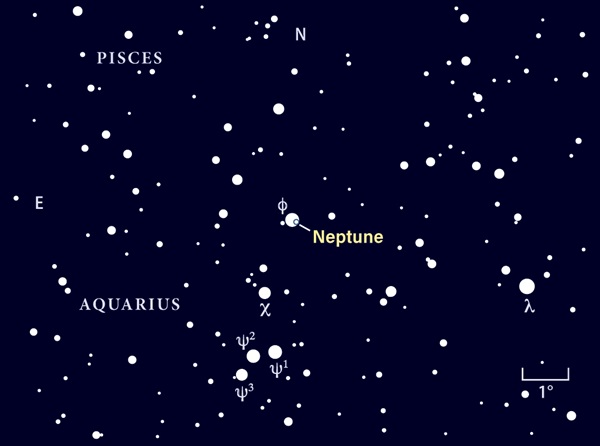The Sky This Week from September 6 to 15 – Astronomy Magazine
A distant world’s close encounter
Neptune lies in eastern Aquarius at opposition the night of September 9/10, when it lies just 0.1° from 4th-magnitude Phi (φ) Aquarii.
Astronomy: Roen Kelly
Neptune reaches opposition and peak visibility tonight (officially at 3 a.m. EDT on the 10th). Because it lies opposite the Sun in our sky, it rises at sunset and appears highest in the south around 1 a.m. local daylight time. But you can start searching for it by 10 p.m., when it stands nearly one-third of the way from the southeastern horizon to the zenith. Neptune glows at magnitude 7.8, bright enough to spot through binoculars if you know where to look. The trick is to find the 4th-magnitude star Phi (φ) Aquarii, which lies about 15° (two binocular fields) east-southeast of Aquarius’ distinctive Water Jar asterism. At opposition, Neptune appears just 0.1° west of Phi. When viewed through a telescope, Neptune shows a blue-gray disk measuring 2.4″ across.
Tuesday, September 10
Although September is typically a slow month for meteors, the International Meteor Organization (IMO) has identified a relatively new shower called the September Epsilon Perseids. Observers witnessed an unexpected flurry of “shooting stars” radiating from the constellation Perseus in both 2008 and 2013. In other years, the rate topped out at five meteors per hour. The shower peaks this morning, with the best views coming after the waxing gibbous Moon sets around 3 a.m. local daylight time and before the start of morning twilight some two hours later. The meteors appear to radiate from the constellation Perseus the Hero, which climbs highest in the sky around 5 a.m.
Wednesday, September 11
If you look overhead as darkness falls anytime this week, your eyes will fall on the brilliant star Vega in the constellation Lyra the Harp. At magnitude 0.0, Vega is the brightest member of the prominent Summer Triangle asterism. The triangle’s second-brightest star, magnitude 0.8 Altair in Aquila the Eagle, lies some 35° southeast of Vega. The asterism’s dimmest member, magnitude 1.3 Deneb in Cygnus the Swan, stands about 25° east-northeast of Vega. Deneb trails Vega by about two hours and passes through the zenith at approximately 10:30 p.m. local daylight time.
Thursday, September 12
Observers of the outer solar system can get good views of Uranus during the late evening hours. The ice giant planet rises around 9 p.m. local daylight time and climbs more than 30° high in the east by midnight. It reaches its peak some 60° above the southern horizon around 4 a.m. Uranus glows at magnitude 5.7 against the backdrop of southern Aries the Ram. Use binoculars to find the planet 2.3° south of the similarly bright star 19 Arietis. A telescope reveals Uranus’ blue-green disk, which spans 3.7″.






